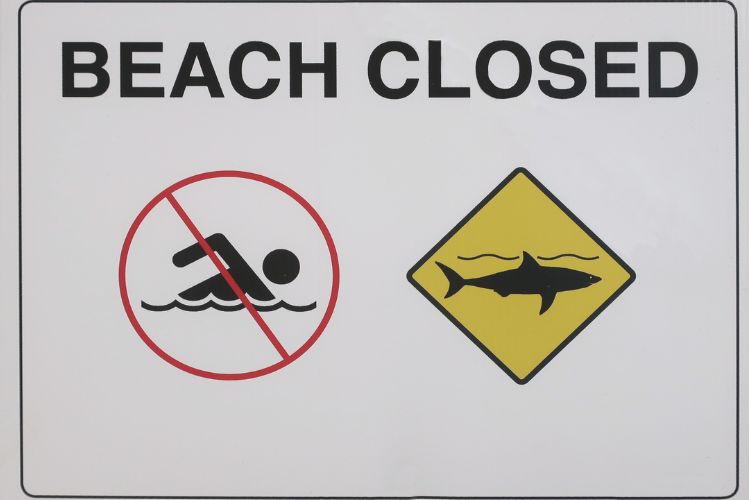Have you ever imagined facing off with one of nature’s most feared apex predators, the shark? While shark encounters are quite rare, their potential occurrence warrants our understanding and preparedness.
Surviving a shark attack may sound like something straight out of a Hollywood blockbuster. Still, for those venturing into shark-inhabited waters, it’s vital to understand the principles of survival and the behavior of these apex predators.
- Misconceptions and Statistics Surrounding Shark Attacks
- Understanding Shark Behavior to Reduce Attack Risk
- Common Shark Species in US Waters and Their Habitats
- Which Species of Sharks Attack the Most?
- Factors That Attract Sharks in US Coastal Areas
- Preventive Measures to Minimize Shark Attack Risks in the US
- Surviving a Shark Attack: What You Need to Know
- Shark Attack Safety FAQ
- Shark Attack Resources
- References
Misconceptions and Statistics Surrounding Shark Attacks
How many shark attacks occur per year?
Globally, the International Shark Attack File indicates that in 2022, there were 129 confirmed, unprovoked shark attacks, 68 of which occurred in the United States. However, fear often exceeds the reality of the situation. Given the millions who swim, surf, and dive annually, the odds of a shark attack are extremely low.
Understanding Shark Behavior to Reduce Attack Risk
Understanding shark behavior can significantly aid in reducing the risk of an attack. Sharks are typically not interested in humans as food; most attacks are believed to be “test bites,” where the shark investigates a novel object. However, if a shark approaches you, it’s critical to maintain a robust and assertive posture. Demonstrate to the shark that you’re a potential threat, not prey.
Common Shark Species in US Waters and Their Habitats
Bull, tiger, and great white sharks are among the most common species in US waters, particularly along the East Coast and Gulf of Mexico. These species prefer warm, coastal waters and are often found near famous beaches.

Which Species of Sharks Attack the Most?
Coincidentally, the “Big Three” species commonly implicated in shark attacks are the white shark, tiger shark, and bull shark. These sharks are particularly noteworthy due to their large size, which enables them to cause significant harm to victims. Moreover, they are frequently found in areas where humans engage in water-related activities. Another factor contributing to their notoriety is their teeth structure, which is designed for shearing rather than gripping. This feature increases the likelihood of serious injuries when encountering these species. However, it is important to note that sharks of almost any species within a certain size range, typically around six feet or larger (approximately 1.8 meters), can pose a potential threat to humans. Even if a shark bite is not an intentional attempt to feed on a human, the sheer power of their jaws and the morphology of their teeth can result in injury. By considering these factors, it becomes evident that these particular species of sharks are more frequently associated with attacks on humans, although other species within a similar size range should also be regarded with caution.
Factors That Attract Sharks in US Coastal Areas
Certain conditions and behaviors can attract sharks in coastal regions.
- Turbulent or disturbed waters: Sharks are attracted to areas with increased activity and commotion in the water, such as strong currents, breaking waves, or rough weather conditions.
- High-contrast colors and patterns: Sharks have a keen sense of vision and are drawn to objects that exhibit bright colors or high-contrast patterns, such as surfboards, swimwear, or equipment.
- Erratic movement: Sudden and irregular movements in the water, intentional or unintentional, can mimic the behavior of injured or distressed prey, catching the attention of sharks.
- Abundant prey: Sharks are attracted to areas where there is an abundance of their natural prey, such as schools of fish or other marine animals.
- Presence of seals or sea lions: Some shark species feed on seals or sea lions, and areas with known populations of these marine mammals can serve as potential feeding grounds for sharks.
Preventive Measures to Minimize Shark Attack Risks in the US
When swimming in shark-populated regions, it’s essential to follow specific safety measures. Stay near the shore, swim in groups, and avoid areas where fishing or baiting occurs. Pay close attention to your surroundings and adhere to local advisories.
- Awareness of Shark Activity in Specific Regions
- Before entering the water, gather information about recent shark sightings or attacks. Local news outlets, beach patrols, and online resources often provide such information. Be especially vigilant in regions with a known history of shark activity.
- Swim in Lifeguard-Patrolled Areas
- Swimming in areas patrolled by lifeguards and obeying their instructions can significantly reduce the risk of shark attacks. Lifeguards are trained to recognize signs of shark activity and have the resources to respond quickly if an incident occurs.
- Avoid Swimming During Certain Times
- Sharks are most active during dawn, dusk, and night, so it’s best to avoid swimming. Sharks may confuse humans for their natural prey in low-light conditions, increasing the risk of an encounter.
- Remove Shiny Accessories Before Swimming
- Shiny jewelry or accessories can mimic the sheen of fish scales under the water, potentially attracting sharks. Before entering the water, removing any items that could provoke unnecessary attention is advisable.
- How to Survive a Shark Attack
- If you see a shark while swimming, staying calm and avoiding sudden movements is critical. Keep the shark in sight and monitor its behavior. Slowly and assertively move away from the shark while facing it. Protect your vulnerable body parts, such as your abdomen and neck. Avoid making direct eye contact or turning your back on the shark, as this may trigger an attack response.
- Protecting Vulnerable Body Parts
- In a shark attack, prioritize guarding vital areas like your abdomen and neck. Use accessible tools for defense while simultaneously distancing yourself from the shark.
- Avoiding Direct Eye Contact or Turning Your Back
- While some marine animals respond to direct eye contact as a threat, in the case of sharks, it doesn’t seem to deter them. Regardless, you should never turn your back on the shark. Keeping the shark in sight is important as it allows you to react to its movements.
- Staying Calm and Avoiding Sudden Movements
- Reacting with panic or quick, erratic movements can trigger a predatory response from the shark. Therefore, staying calm and avoiding sudden movements can help you avoid escalating the situation.
- Slowly and Assertively Moving Away from the Shark While Facing It
- When in proximity to a shark, the safest way to retreat is by slowly and assertively moving away from the shark while keeping it in sight. This can show the shark that you’re not easy prey and give you a chance to return to safety.

Surviving a Shark Attack: What You Need to Know
One of the most common fears surrounding ocean activities is the possibility of encountering a shark. Although these encounters are relatively rare, they happen, and knowing how to survive a shark attack can be a lifesaver.
- Fight Back: Aggressive Techniques in a Shark Attack
- Knowing what to do in a shark attack is crucial. The last resort is to fight back if a shark attack is imminent. Sharks respect strength and are likelier to back down if they realize you are not an easy meal. Aim to make solid, aggressive movements to dissuade the shark from seeing you as prey.
- Targeting Sensitive Areas During a Shark Attack
- If a shark attack intensifies, focusing on its sensitive areas could enhance your survival chances. Aim for the eyes, gills, or snout—the most sensitive parts of a shark. Your goal should be to startle the shark long enough to create an opportunity for escape.
- Using Objects as Shields or Weapons
- Any available objects can be turned into defensive tools. This could be a diving knife, a camera, or a snorkel. Use these items to keep the shark at bay or to strike its sensitive areas if necessary.
- Exiting the Water Safely and Quickly
- Once the shark has been deterred, your next step should be to exit the water as quickly and calmly as possible. Panic can attract more attention from the shark or others nearby, so maintaining a steady pace is critical.
- Seeking Immediate Medical Attention
- If you or someone nearby has been injured, seek immediate medical attention. Untreated, minor injuries can result in severe infections. For more severe injuries, call 911 immediately and ensure the individual receives professional medical care.
- Assisting in a Shark Attack Situation
- Knowing what to do can make all the difference if you witness a shark attack. Remember to prioritize your safety before attempting a rescue. Swimming into a situation where a shark attack has just occurred could also put you in danger.
- Contacting Emergency Services
- Upon witnessing an attack, immediately contact emergency services. 911 operators can provide crucial first aid instructions while dispatching local authorities to assist.
- Providing Immediate First Aid
- Once you’ve alerted emergency services, you can provide first aid. Apply pressure to any bleeding wounds with a clean cloth or bandages. If the victim is unconscious, maintain an open airway and perform CPR if necessary.
- Using Improvised Tourniquets for Severe Bleeding
- In cases of severe bleeding, improvised tourniquets can be helpful. Apply the tourniquet above the wound, not on it, to effectively slow the bleeding until professional medical help arrives.
- Keeping the Victim Calm and Warm
- Always keep the victim calm and warm while waiting for medical help since it can improve their chances of recovery. Hypothermia is a risk, especially if the victim has been in cold water for an extended period.
- Post-Attack Considerations and Recovery
- Surviving a shark attack extends past the event itself. The recovery phase, both physically and mentally, can be demanding and supportive measures are essential. Experiencing a myriad of emotions post-trauma is normal. If dealing with anxiety, flashbacks, or PTSD symptoms, seek professional mental health assistance.
Knowledge and preparedness are our best defenses against shark encounters. Understanding their behavior, adhering to safety measures, and knowing how to react can significantly reduce risks. Whether you’re a beach-goer or an ocean adventurer, our guide equips you to enjoy the wonders of the sea with confidence and safety.
Shark Attack Safety FAQ
How many shark attacks per year?
The average number of reported shark attacks worldwide is around 80 annually, according to the International Shark Attack File (ISAF).
What shark has killed the most humans?
The great white shark causes the highest number of human fatalities among shark species at 59. However, it’s important to note that such incidents are relatively rare, and shark-human interactions should be understood within the context of their natural behavior and habitat.
How common are shark attacks in the US?
Shark attacks in the US are relatively uncommon. It’s important to note that the US has extensive coastlines and millions of people engaging in water-related activities, so the risk of shark encounters remains low. Proper awareness, education, and precautions can help mitigate any potential risks.
Shark Attack Resources
References
- Ugoretz, J., Hellmers, E. A., & Coates, J. H. (2022). Shark incidents in California 1950-2021; frequency and trends. Frontiers in Marine Science, 9, 1020187. https://doi.org/10.3389/fmars.2022.1020187
- NOAA Fisheries | Shark Research
- Cooper JS, Kong EL, Murphy-Lavoie HM. Shark Trauma. [Updated 2022 Sep 12]. In: StatPearls [Internet]. Treasure Island (FL): StatPearls Publishing; 2023 Jan-. Available from: https://www.ncbi.nlm.nih.gov/books/NBK507855/

